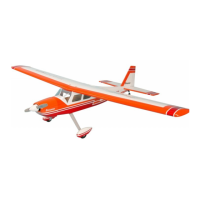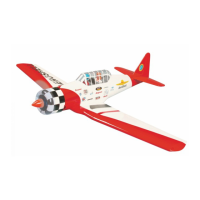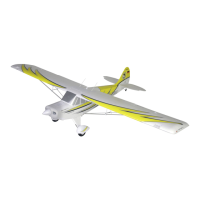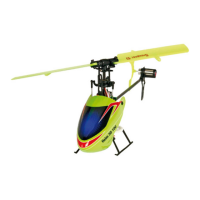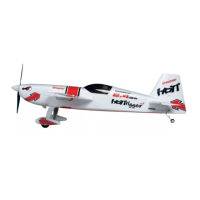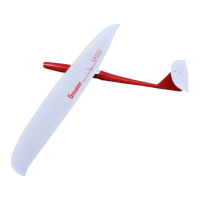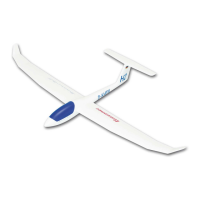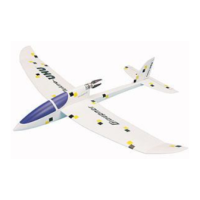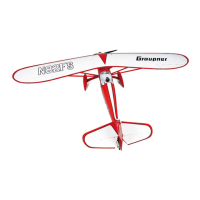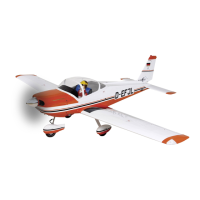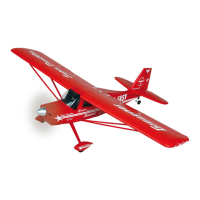GRAUPNER GmbH & Co. KG D-73230 KIRCHHEIM/TECK GERMANY
Änderungen vorbehalten! Keine Haftung für Druckfehler! Ident-Nr. 0057999
Made in Thailand
04/2003
64
64
− Connect the formed rod (No. 49) and the rubber band to the steering cables (No. 46) of the steerable
noseleg, so that the steering cables are pulled upward when the noseleg unit is retracted (Fig. 6a).
− When the retractable undercarriage is completely installed and working, carry out a comprehensive check
procedure so that you are confident that the whole system works with complete reliability.
− Be sure to read through the instructions supplied with the retract system, Order No. 175, several times,
taking particular note of the instructions regarding methods of working and maintenance.
Canopy
There are several methods of completing the canopy (No. 2):
− Attach the associated fixings (No. 20, 20a, 21) to the GRP moulding (No. 2) as shown in (Figs. 7, 7a, 7b,
7c).
− First glue the cockpit former (No. 21) in the fuselage (Fig. 7). Caution: the 5 mm gap between the support
surface and the plywood former (No. 21) is absolutely essential.
− Glue the plywood canopy retainer components (No. 20 and 20a) to the GRP canopy moulding (No. 2).
Place the canopy (No. 2) on the fuselage (No. 1) and drill a 6 mm Ø hole through the rear canopy former
(No. 20), the cockpit former (No. 21) and the fuselage in one process (Fig. 7c). Open up the hole in the
fuselage cockpit former (No. 21) to 7.2 mm Ø, and fix the M6 captive nut (No. 11) in it. Open up the 6 mm
Ø hole in the GRP canopy moulding (No. 2) to 11 mm Ø, and screw the canopy (No. 2) to the fuselage (No.
1), using the M6 nylon screw (No. 12).
− Mask out the canopy frame and paint the canopy in the scheme of your choice.
or
− Cut away the GRP canopy (No. 2) to form a support frame for the clear canopy (No. 3) (Fig. 7d).
− Trim the GRP moulding (No. 2) along the marked line (or cut it to the shape you prefer) as shown in (Fig.
7e). Cut out and trim the clear canopy (No. 3, Fig. 7d) to match the outline of the support surface for the
GRP canopy (No. 2) on the fuselage (No. 1), and glue the canopy to the frame using Stabilit express (Fig.
7f).
− Note that the completed canopy (No. 3) should be glued over the top of the canopy frame (No. 2).
− Before you glue the parts together paint the inside of the frame and the canopy flange. Glue the canopy to
the frame and carry out any final trimming required when the glue has hardened.
General information on control linkages
− All pushrods for the wing-mounted control surfaces are made from the 1000 mm length of M3 studding
(No. 51). Cut the rods to the required length and fit M3 clevises (No. 55) on each end. Lock all clevises
with M3 nuts (No. 58). Naturally the M3 clevises (No. 55) can be soldered to the rods if preferred (Figs. 13,
13a, 14a, 14b).
− The pushrods which actuate the rudders, thrust vectoring system and speedbrake are cut from the M2.5 x
1000 mm studding (No. 52). They should be completed using the aluminium ball-links (No. 57), M2.5
clevises (No. 56) and associated M2.5 locknuts (No. 59). Fit the 4/2.5 mm Ø brass tube (No. 53) on the
M2.5 studding to stiffen the pushrods (Figs. 13, 13a, 14b, 18).
− Only the rudder and thrust vectoring pushrods need to be stiffened using the brass tube (No. 53) as shown
in the illustrations.
Speedbrake linkage
− Connect the servo and pushrod to the speedbrake (Fig. 8), and shrink a piece of heat-shrink sleeve (No. 48)
round the servo. Cut down the Novotex actuating lever (No. 15) to the length shown.
− Glue the sleeved servo to the floor former (No. 23) using thick cyano (Fig. 8a). Tack the Novotex lever
(No. 15) to the speedbrake using thick cyano, and reinforce it with small pieces of GRP (No. 30) (Fig. 8b).
Caution: maintain the stated distance between the pushrod / servo and the Novotex lever (No. 15).
− Cut the pushrod between servo and speedbrake to the correct length and adjust it carefully (the digital
Servo Tester, Order No. 763, is useful here).
− Complete the pushrod as described under “General information on control linkages”.
Rudder servos
− Screw the rudder servos to the factory-installed formers, working through the turbine access hatch (Fig. 9).
− Fit output arms of adequate length on the rudder servos; they must project through the pre-cut pushrod slots
on the top of the fuselage (Fig. 9a). Fit extension leads of appropriate length to the servo leads (Fig. 9a)
(servo extension leads, Order No. 3935.75).
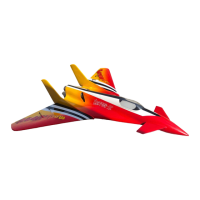
